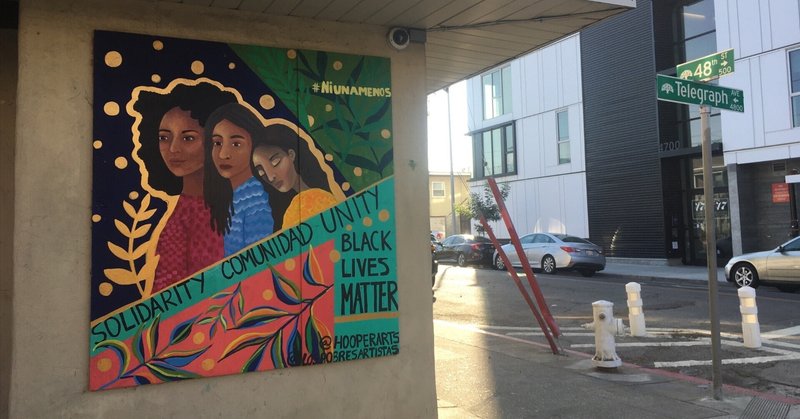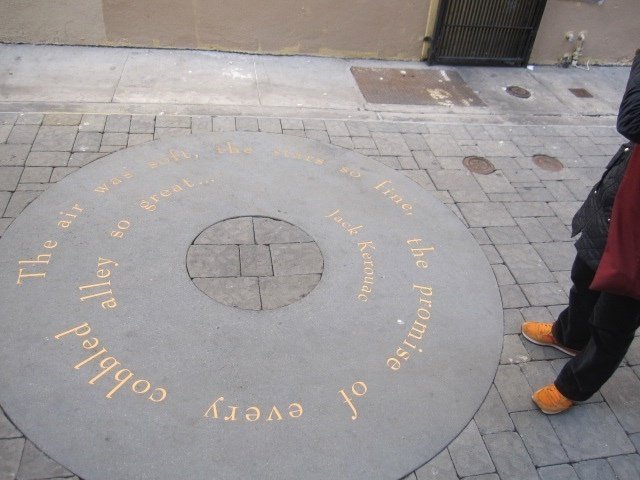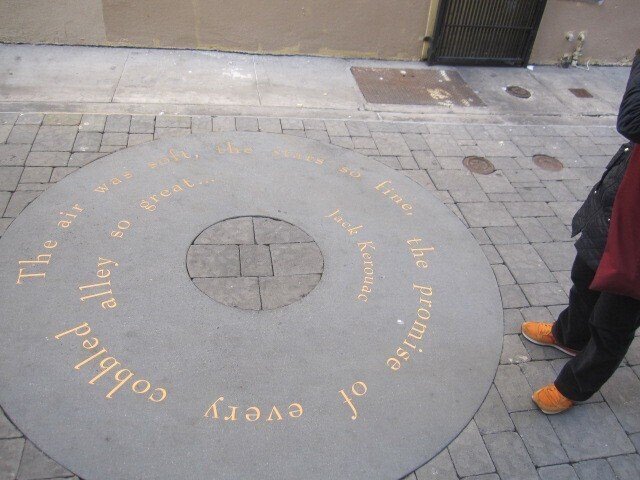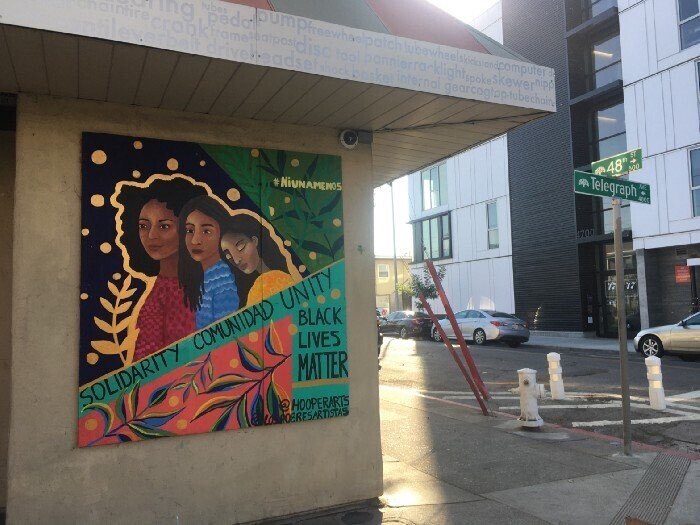
ベイエリアの焦眉の急と美〜サンフランシスコベイエリアの詩〜 / The Urgency and Beauty of the Bay 〜San Francisco Bay Area Poetry〜
ジュディ・ハレスキ著
高橋綾子訳
私はミルズカレッジでの勉学のために二十代のはじめにカリフォルニアに移ってきた。カリフォルニアの威厳ある思考に出会い、またビート詩人、アレン・ギンズバーグや彼の「バークレーの奇妙な新しいコテージ」[1]や「カリフォルニアのスーパーマーケット」[2]に出会った。私がベイエリアに来たのは1996年なので、ギンズバーグがシックスギャラリーで『吠える』を朗読し[3]、ローレンス・ファーリンゲッティがシティライツ書店[4]を開いてから40年以上も後のことである。今やかつての野生の自然は踏みつけられ、住宅・交通需要に伴う都市部拡大が進んでいるようだ。しかし、カリフォルニアは、いまだに活力が満ち、社会的文化的可能性を有し、進歩、そして創造がなされている。カリフォルニアの規則は破られたり、捨てられたりしているかもしれない。特に、詩人、舞踏家、音楽家たちがここで素晴らしい仕事をしていると感じている。例えば、マーサ・グラハム[5]はミルズカレッジの芝生で踊り、ノースビーチのバーで詩の朗読を行っていた。この感覚がこの地の物理的な土地や気候に反響する。温暖な日々と温かさが夕方まで続くことが、この地で明朗かつ情熱的に暮らす希望の前兆となる。私が過ごしたノバスコシアでの生活とは対照的に、耐え忍び、静まり返り、ずっと座っているような季節は全くなかった。カリフォルニア大学バークレー校に通じる大学通りに中庭付きのカフェを見つけた。私はアーモンドの花が咲き始めた木の下に座り、ミルクを飲みながら読書し、書き物をしたものだった。夜に咲くジャスミンが時折私を他の作家たちにつなげてくれた。ツンと匂う花の蔓、終わりのない夏のような夜が、一人で読書するページや人生の深い時間へといざなった。

サンフランシスコベイエリアにおける最近の詩の中で、焦眉の急という重要な感覚がある。詩人たちは特に人種差別が国中で勃発した「ブラック・ライヴズ・マッタ―」(黒人の命は大切)を通して、中心課題となっている広範囲でかつ文化的諸問題について書こうとしている。これとの合意は、長い歴史に渡る人種差別を無視、又は意図的に忘れている白人社会及び移住者文化、そして合衆国におけるあらゆる局面で白人特権の触腕がどれほど浸透しているかを考察することだ。2018年、シックスティーン・リバー・プレスは、選集『アメリカ、その名を呼ぼう、抵抗と回復の詩』(America, We Call Your Name: Poems of Resistance and Resilience)[6]を出版した。広範囲におよぶ詩は抑圧に抵抗し、不平等に対して反応し、正義の可能性を幻視する。環境問題もまた、重要かつ恐ろしい。2020年10月時点で、空気は乾燥し、風も強いことが山火事の危険を増長させる。電力会社は強風が山火事の原因となるため、10万人の顧客に対して計画停電を実施している。このようなことはかつてなかった。気候温暖化に伴い、カリフォルニアの風景はますます乾燥している。モリ―・フィスク(Molly Fisk)は、『カリフォルニアの水と火災、気候危機選集』(California Water & Fire: A Climate Crisis Anthology)[7]を2020年4月に編集し、荒廃する山火事を伝えている。私は2020年の大統領選挙の前にこれを書いている。我々の民主主義的手続きを放り出そうとして外国政府と共謀するような政権のもとに4年間過ごし、その政権は現役の人種差別主義者であり、国境で家族から子供たちを別れさせ、気候変動と決別した。まさに、緊急事態なのである。詩人は必死にこれらの問題に注意喚起するように促した。同時に、詩は、我々の感情生活、日々の交流や日常の物事で発見する美しさ、そして執筆を通して発見される光、強さ、失意、失敗の瞬間に寄り添う手段としてあり続ける。 ベイエリアで最も有力な詩人の一人はロバート・ハス(Robert Hass)である。サンフランシスコ・ルネサンスの以降、彼の作品は北カリフォルニアに根付くものだ。ハスは、1941年サンフランシスコで生まれ、マリン郡で育ち、今は東ベイに暮らしている。彼の詩においては、しばしばベイエリアの風景や場所、特定の場所を名づけると同時に季節や植生などを想起する。ハスの詩は野生の感覚的な経験、つまり、感覚、味覚、嗅覚における感情、記憶における豊かさ、願望、言語の美しさや減退である。彼の作品は心穏やかで、機転が利き、また正確である。彼の作品には、長編詩や一連の詩があり、物語や抒情的情景における詩的瞬間を構築している。今、詩を書く多くの詩人たちと同様に、彼の作品でも環境的堕落、銃暴力、合衆国における不平等などが取り上げられ、より広範囲のテーマの詩がある。

2010年、エコ出版は『オレマのリンゴの木』[8]を出版した。この選集はハスの初期の本から最近の作品まで収録している。タイトルとなる場所の名前「オレマ」はポイントレイアス半島の東端にあるマリン郡の小さな町の名前である。この本のタイトルは1989年の『人間の願望』(Human Wishes)からも収録されている。この詩はハスの自然界、世界への一貫した注意を示しており、その詩は「彼らは海岸沿いの森に歩いていく 草むらの中に 疲れて 出会う 誰も知らない林檎の木が二本」で始まるこの詩は乾燥していて荒れているが生き生きとした周辺の科学的学名によって構築される。そこでは現存の名前を探すこと、名前をなくす可能性の両方に対する戦いがある。
青い目、ポピー、ルピナスの群生
草原に広がる 入り組んで切る虎模様
葉のような緑色の花、その名前を思い出せなかった
カタクリ、と彼は言い、彼女はクサリヘビの舌[9]と言った
この認識と名付けることはその双方にある見落とした内的連続性へと発展する。彼らは見ている世界はそれぞれのものとは異なるが、話し手が望むやり方では共有されていない。「林檎の花にある 生の白、舞い落ちてくる光に 彼女は震え 何かが証明されたかのように 彼は大喜びする」これはあやまった連続であるが、話し手にはある種の親近感がある。その詩は強力で生き生きとしたオレマの午後の情景で再接続の瞬間を迎える。
湧き上がる泡の中で光がつかむ
砂州にゴシキヒワ[10]の色
彼らは光の中に鈍く輝く黄金色に気づく
草原のあたりで。彼らはともに鳥を敬い
近づき、また歩き始める。
これは歩み、停止、分離、再接続、そしてまた歩みという構造を伴う詩の結末であろう。しかしながら、その詩はまったく異なる結末へと向かい、カリフォルニアのオレマの森や海岸の描写にもはや基づくものではなく、同時に二人の大人の交際でもない。最終行は、二人の歩き方と少年がいろいろな部屋のドアを眺めながらホテルの長いホールを歩く描写とをつなげている。少年には孤独と好奇心の両方がある。自分の部屋を持つことが少年に所属感を与える。それにより、彼は他人の中にも関わらず、世界を探求できるのだ。
彼は自分の部屋の
番号をもって心の中心に近づき
悲しくそして繊細に まるで鍵のように
そして彼が求めたものすべてを
見知らぬ人の中にさまよう
この最終行は詩の中で分離しており、二つの際立った瞬間を創り出し、それぞれはおたがいに内的な経験を創り出す。私が好きなハスの作品の中で、これがもっともわくわくするものであり、詩の形式や方向付けが記憶や経験の無意識的探求から現れてくるものだ。つまり、名付けと語りとの葛藤があるのだ。しかし、使用するイメージ、言語、表現しようとして語らず考えないことは統合する方法である。これにより、詩全体を、なめらかで美しいものでなく、内的で傷ついた優しい生命と共鳴するものにするのだ。
ジョヴァンニ・シングルトン(giovanni singleton)は、ジョアン・カイガー(Joanne Kyger1937-2017)[11]を通じてカリフォルニアの詩人の系譜にある。シングルトンは、ヴァージニア州リッチモンドに生まれ、サンフランシスコ東ベイに位置するモラガにあるセント・メアリーカレッジでの勉学のためにカリフォルニアに移ってきた。彼女はマリン郡で長く暮らし、グリーン・ガルチ禅センター[12]で学んだ。彼女の作品は詩の最先端の可能性、即ち、詩が紙面や具象的経験の中でどのように生きうるか、について推し進めている。彼女の詩の多くはイメージとして機能し、他は「パフォーマンススコア」と区別され、あたかも印字された詩が演技やテキスト即興として想起される活動詩のガイドのようである。彼女は、多彩な本を書いている。彼女の最初の本、『上昇』(ascension)[13]は2012年カウンターパスから出版され、カリフォルニア図書賞を受賞した。彼女の第2作は、『アメリカの手紙 書面の営み』は2018年カナリウムから出版された。この選集の大部分は具象詩またはビジュアル詩である。ベイエリアに根ざしていることを際立たせているのは、シングルトンがサンフランシスコ・ルネサンスの数々の影響を前進させていることである。執筆のプロセスに焦点をあて、例えば「聞く耳の耳」というシリーズでは、音楽家で精神的な指導者であるアリス・コルトレーン(Alice Coltrane)[14]を追った日常の詩がある。彼女は創作のプロセスとしてまた「調停仲介」を使用する。何よりも、彼女の作品は現代詩の確立した伝統的要素(パラメータ)の中に留まることに抵抗を表明する。彼女の詩が文学雑誌に簡単に再生されない理由は、それらに複雑なレイアウトや手書きのイメージがあるためである。また、彼女はアコースティックな形式や初歩的形式等幅広い形式でも詩を書いている。
『アメリカの手紙』[15]の第3部は、「無」という言葉の繰り返しで描かれる一頭の牛のイメージを含む一連のビジュアル詩である。これは言葉遊びでもある。ウシは「モー」と言うが、「無」とも言う、つまり、禅仏教の「無」という概念、より単純化すれば、日本語で「無」は何もないことやゼロの意味を類推するのである。対面ページには七つの言葉の列があり、下に向かってその言葉や文を繰り返し、部分によっては文字が重なり読みにくい。一連の言葉には「無(mu)」、「存在しない(nothing)」、「なしで(without)」が繰り返され、他の言葉と重なっている。他の言葉の上部に印字されるという混乱にもかかわらず、「犬に仏性があるか」、「犬に仏性があるか」[16]という詩行は理解できるのである。この詩は、真剣でかつユーモラスであり、詩を創り出す認知の瞬間、象徴の衝突、詩が創る意味の生成を創り出す。これらの象徴がどのように機能するか、我々はどう読むのか、どのように意味を創り出すかを問いかける。これらの象徴は空気中に投げ出される。我々は一瞬において詩を経験し、そのとき、これらの概念はあけ放たれ、予期していた意味から自由になる。
『アメリカの手紙』第5部は、平等というタイトルで人種問題や銃暴力を取り上げる。この一連の詩は2020年の夏から露わになった「ブラック・ライブズ・マター」運動、白人警官によるジョージ・フロイド(George Floyd)[17]の殺人が発端となった問題に直接語りかけてくる。この作品はアフリカ系アメリカ人の法廷外の殺人に対して大注目される前に執筆され出版された。この暴力への地うねりがある一方で、これこそが、多くの命を奪うことへの関係、暴力に傷つきやすいという真の感覚に拠って、実際に人が亡くなり、より多くの命に触れるような長期に渡る問題なのである。この一連の事件は左側のページに銃と右側のページにある旧式のビデオカメラの対照的なイメージで始まる。読み進めると、「撃つな」は、ビデオ証拠により、暴力への証言を行使する力、例えばロドニー・キング(Rodney King)事件[18]における暴打ビデオ、ジョージ・フロイドが地面に押し付けられるビデオを想起する。また、内密性や如何なる形式の知識が権力によって認知、承認されうるかをほのめかすものだ。この詩の別の階層では、映像、声、詩を通しての証言の力がある。この一連の詩の別のページには、「blk」(黒人を表す)という言葉があり、「白」ページに行で分けられており、下部に手書きがなされている。
そこに一艘のボート。そこに一対の
櫓(オール) 前進しまた
岸から向かって動くために
青は壊す。幽霊は
川から現れる。
熱や恐れを顕す
この詩には抒情的な瞬間があり、人種差別の暴力の歴史を想起させる。「幽霊が川から現れる」は、最近の暴力事件に直接結びつくような合衆国のリンチの歴史を類推させる。「幽霊」の登場は、この過去を最小化、隠ぺいし、または現代は過去とは全く別であると主張する白人社会の数々の試行がなされたにも関わらず、この歴史はいまだに我々と共にあり未解決のままという点で、初期の詩を思い出させるのである。
今や親愛なる読者は、シングルトンが我々人間の闘いに広い視野に立脚する共感をもち、同時に紙面の記号のもつ形式的な質感に対する詳細な関心があることにお気づきだろう。彼女は大文字を避け、それが表す力の区別を避ける。また彼女は、作品が紙面と読者にもたらすメカニズムに基づき、日常生活に基づく作品形成の仕方から、作品と紙面とが読者にもたらすメカニズムまで、創作のすべての局面に対する関心をもつ限りのない詩的精神の持ち主である。
サンフランシスコ詩人のディーン・レイダーは、最近『ウィキペディア入門としての自画像』(Self-Portrait as Wikipedia Entry)[19]という本をコッパ―・キャニオン社から出版した。レイダーはオクラホマで育ち、成人してからカリフォルニアに移ってきた。彼の作品は豊かな情熱的音調があり、ユーモアがある。彼の作品はハスやシングルトンの作品に見られる都市生活やポップカルチャーにより直接的に関わっている。その詩は異なる表現の中を形式的に跳躍する。絵画作品のような詩形成の連続するモチーフがある。しばしば画家、特にポール・リー(Paul Klee)[20]への言及があり、自画像が絵画として構想しているとわかる。冒険詩、予言、死後の世界百科事典の入り口のような詩などの選択もある。
詩集のタイトルとなっている「ウィキペディア入門としての自画像」は、オンラインの百科事典のページ上にリンクするようにオンラインで出版された。詳細な説明が詩人とは異なる一方で、著者の自伝のようにコレクションの最終頁で印刷されている。「ダン・レイダーはカリフォルニア州ストックトンに愛の夏の間に生まれた。彼の悲しみは彼自身である」それは、言語と意味における驚くべき移動の野生の配列の中に続き、一つのレベルでは著者の自伝ジャンルを嘲り、別のレベルでは作家の道を明らかにする。「レイダーの父は葬儀屋になるために勉強し、母はセラピストだった。驚くことはなく、レイダーは両方の道を進んだ。」一方で葬儀屋とセラピストの両方になることは不可能でおかしなことに見えるが、これはまた詩人になることは死人を気にかけることで生きている人のメンタルヘルスをよく知ることだ。その詩は、ねじれをもって終わり、神話が詩人の作品に付随すると想起させる魅力的詩文、「専門家は本物を疑う」という事実上の真実において、詩のアイディアとの決定戦を行っているのである。
レイダーの詩の一つに「アメリカ、希望なくして君の名を呼べない」(America, I Do Not Call Your Name without Hope)というタイトルのベイエリアの現在の瞬間をよく伝える詩がある。この詩はパブロ・ネルーダ[21]の詩と同じタイトルの詩を類推させる。ネルーダの詩は、大陸としてのアメリカが表明し、一方でレイダーの詩は個人化されロマン化された理想としてのアメリカという言葉を使いながら、合衆国を直接的に語るものである。ネルーダとレイダーの双方の詩は痛ましい喪失感を表明し、その継承に取り組むものだ。レイダーの詩はまた恒常的な暴力の中で楽観主義という薄弱な岸辺を差し出す。それは次のような引喩、「私に手錠をかけろ 私の背中で」、「手錠はつながる」あたかも逮捕中のようである。
アメリカ人 希望なくして君の名前を呼べない
私の咽喉を君のナイフで押し付け、
私の背中で 手を縛りつけるときでさえも
手錠はつながる
私たちを 無法者二人 白馬の歴史から
逃れようとするように それはひどい鞭
耳にピストルの跡
「無法者」という名の話し手とアメリカは、英国法との絶縁により建国した合衆国という幻影、東海岸に拠点を置く政府の束縛から距離をとる「野生の西部」として西海岸という幻影に自惚れた。これは、また原住民から土地を奪い、「君の背中に傷」のフレーズにある奴隷制を類推させる。
失われた土地
君の背中にある傷のための歌
水疱のある脚と美しい
時計、君の風車のために 君の
魔法の機械のため、君の握り拳のため
この詩は2014年のエリック・ガーナー(Eric Garner)[22]とマイケル・ブラウン (Michael Brown)[23]の殺人の後に数日後に書かれた。合衆国の読者は即座にこれらの名前を警官の手で亡くなった男たちの名前と認識する。ガーナーは一箱のタバコを不適切に売ったことで逮捕された。一人の警官はガーナーに禁じられている違法窒息術を行使し、複数の警官が歩道に彼を抑えつけた。この事件の映像はガーナーが繰り返し「息ができない」と言っていることを示す。警官はガーナーの訴えを無視し、彼は意識を失い亡くなった。その映像は伝染し、「息ができない」は抗議者によって歌われるスローガンになり、標識やTシャツに印字された。その詩は「呼吸の歌、呼吸のための誓い」という最終行に反響する。その詩の第二スタンザの半分は、愛情と恐れの間の揺らぎである。
これは君のため、君の恐れのため、君のヤニのため
君の肌の白い熱、そして
いつか歌うかもしれない青い骨のため
これは君のための歌、過去のため
単に過ぎ去ったものではなく。これは夜明けのため
そして疲労、夢のためそして闇のため
この歌は君の闘いのためではなく、本当の
闘いのための歌。炎の歌であるが、燃え尽きない。
呼吸の歌であり、呼吸のための誓い。
君が私のドアをノックするときに私が歌う歌
君の口のなかで私の息子の名前を
その詩は歴史の認識と歴史の賛美をはっきりと区別する。最終行によって、話し手は、行動とこの土地の無防備さの中に留まる。この詩は、明確な方向性を持たない歴史の流れの中に、現在へと続く過去の中に、子どもたちを通じて未来へと向かう現代の中に生きていることを知らせて終わりとなる。この詩は、2016年の選挙の直後にサンフランシスコクロニクル新聞に掲載され、以来複数の選詩集に掲載されている。選挙の批判として、また警官の暴力に対する声としても読まれ、今日のアメリカ社会の複雑さと傷心をより広く伝えている。
私が愛するベイエリアの詩のすべてについて、別々の論考を書いたつもりであるが、これらの問題が我々の生活に浸透し、注意を求めるものであってほしいと思う。しばしば詩はすぐ隣の雑音や日常生活の注意散漫から我々を隔てることに関わっている。それが魅力の一部である。詩はありふれた日常から隔絶してくれる。しかしながら、州が支援する暴力、激怒したような山火事で立証される気候変動はありふれた日常ではない。それらは我々の安全、限界、可能性の感覚を脅迫し、我々の表現の自由を委縮させ、我々の呼吸でさえも弱めさせる。もちろん、このような詩人たちすべて、それ以上の多くの詩人たちはあらゆる思考や経験から生み出される創作のためこれらの問題から距離を持つ時間を見つけている。しかしながら、私たちは、この瞬間の焦眉の急と結びつきながら、今ここで、生活し、呼吸をし、創作しているのである。

[1]“A Strange New Cottage in Berkeley” はCollected Poems 1947–1980. New York: Harper Perennial(1988)に収められている。
[2]“A Supermarket in California”はギンズバーグのHowl and Other Poems(1956)シティライツ出版の中に収められている。
[3] 1955年、10月7日、サンフランシスコのシックスギャラリーで初めて朗読し、翌年出版した詩集『吠える』
[4] サンフランシスコノースビーチにある1953年設立した、全米初の全図書がペーパーバックの書店。ギンズバーグの『吠える』の出版等、「シティライツ書店を語ることなしにビートジェネレーションは語れない」と言われる。
[5] Martha Graham(1894–1991)アメリカの舞踏家、振付師。
[6] America, We Call Your Name: Poems of Resistance and Resilience. Ed. Murray Silverstein. Sixteen Rivers Press, 2018.
[7] California Fire & Water: A Climate Crisis Anthology. Ed. Molly Fisk. Story Street Press, 2020.
[8] Hass, Robert. The Apple Tress at Olema: New and Selected. Ecco Press 2010.
[9] カタクリの別名
[10] lesser finch北米土着の小型の鳥
[11] ジョアン・カイガー(1937–2017) カリフォルニア州出身の現代詩人。サンフランシスコ・ルネサンス、ビートジェネレーション、ブラックマウンテン、ニューヨーク派と関係をもった。鈴木大拙の禅に出会い、1960年から日本行き、ゲーリー・スナイダーと結婚。1964年スナイダーを残して、サンフランシスコに戻り、翌年離婚。ボリーナスに暮らし、生態地域主義運動に参加、サンフランシスコやコロラド州ボルダーのジャック・ケルアック詩の学校などで詩を教えた。
[12] 鈴木俊隆がカリフォルニアミューアビーチに開山した曹洞禅センターで、蒼龍寺。
[13]singleton, giovanni. Ascension. Counterpath, 2012.
[14] アリス・コルトレーン(1937–2007)アメリカのジャズ音楽家、作曲家、ジョン・コルトレーンは夫。
[15] singleton, giovanni. AMERICAN LETTERS: works on paper. Canarium Books, 2018.
[16] 『無門関』の冒頭において、「犬に仏性はありますか」と超州和尚に問い、「無」と答えた。禅宗に打ち込むときに「無」が最も重要であると説く。
[17] 2020年5月25日にミネソタ州で起こったジョージ・フロイド死亡事件。
[18] 1991年3月3日カリフォルニア州で起こったロドニー・キング事件。逮捕時の警察官による暴力の映像が全米で放映され、ロサンゼルス暴動となった。2017年スパイク・リー監督によって「ロドニー・キング」として映画化された。
[19] Rader, Dean. Self-Portrait as Wikipedia Entry. Copper Canyon Press, 2017.
[20] ポール・リー(1849–1940) スイス系のドイツ人の芸術家。キュビズム、シュールレアリスムに影響を与えた。
[21] パブロ・ネルーダ(1904–1973) チリの詩人、外交官、政治家。1971年ノーベル文学賞受賞。
[22] 2014年7月17日ニューヨーク州で起こったエリック・ガーナー窒息死事件、白人警察官は不起訴。
[23] 2014年8月9日ミズーリ州で起こったマイケル・ブラウン射殺事件(ファーガソン事件)、白人警察官は不起訴。この事件はドキュメンタリー映画Whose Streets?となった。
The Urgency and Beauty of the Bay
San Francisco Bay Area Poetry
By Judy Halebsky
I moved to California in my early twenties to study poetry at Mills College. I came with majestic ideas of California and the Beat Poets, particularly Allen Ginsberg and his poems A Strange New Cottage in Berkeley and A Supermarket in California. Of course, I was getting to the Bay Area in 1996, more than forty years after Ginsberg performed Howl at the Six Gallery and Lawrence Ferlinghetti opened City Lights bookstore. Some of that wildness seems trampled now in the growing urban area with struggles for housing and transportation. But still there was an energy, one of social and cultural possibility, that things could be made and created here, that rules could be broken and the discarded. Particularly, I had a sense that poets and dancers and musicians had made their greatest works here, such as Martha Graham dancing on the lawn at Mills College and the poetry readings in North Beach bars. This sense was echoes in the physical land and climate here. The warmth of the days and how they stretch into early evening seemed to me to signal the possibility of living vividly, living intensely. In contract to my life in Nova Scotia, Canada, there was never a season to endure or quiet down into or sit through. I found a café in Berkeley where College avenue meets the UC Berkeley campus with an outdoor patio. I would sit there under the early bloom of almond trees and drink lattes and read or write. Night blooming jasmine connected me somehow to those writers. The pungent blooming vines and the intensity of these endless summer-like nights brought the pages I had read alone and in dark hours to life.

Within the recent poetry of the San Francisco Bay Area, there is an overarching sense of urgency. Poets are writing to address a wide range of cultural issues particularly racism which has been brought to the center of attention through Black Lives Matter protests taking place across the county. Tied with this is a reckoning on white society and settler culture that ignores and intentionally forgets the long history racism and how the tentacles of white privilege permeate almost every aspect of life in the U.S. Poets are also finding ways to speak out of gender identity, sexuality, ability, and the rights of indigenous people. In 2018, Sixteen Rivers Press published the anthology, America, We Call Your Name: Poems of Resistance and Resilience. The wide-ranging poems resist oppression, respond to inequality, and envision possibilities for justice. Environmental concerns are also pressing and dire. Right now, in October 2020, the air is dry and there are high winds, which raises the risk of wildfires. The power company is temporarily shutting down service to hundreds of thousands of customers because high winds can cause sparks that start fires. It wasn’t always this way. The landscape is drier now because the climate is warming. Molly Fisk edited the anthology, California Water & Fire: A Climate Crisis Anthology, published in April 2020, that addresses the devastating fires. I’m writing this in the days before the 2020 election. We’ve had four years under an administration that has colluded with foreign governments to throw our democratic process, is actively racist, has separated children from their families at the border, and has dismissed climate change. Yes, it’s urgent. Poets are desperately trying to raise attention to these issues. At the same time, poetry continues as a means to attend to our emotional lives, the beauty that can be found in our everyday interactions and surroundings, and the moments of light, intensity, heartbreak, failure and beauty found in writing poems.

In 2010, Ecco press published The Apple Trees at Olema. This volume offers selected poems from Hass’ earlier books and also includes new work. The place named in the title, Olema, is a small town in Marin county on the eastern edge of the Point Reyes peninsula. The title of the book is taken from a poem included in this volume from his 1989 book, Human Wishes. The poem shows Hass’ constant attention to the natural world, the work of naming that world, the vivid sensory presence in the outdoors of noticing one intricate detail and then the next as the speaker and a companion walk through the woods. It begins, “They are walking in the woods along the coast/and in a grassy meadow, wasting, they come upon/ two old neglected apple trees.” The poem builds with a near scientific naming of their surroundings which might be dry and withered but even so, every living thing is detailed. There’s a struggle to name in both searching for existing names as well as possibility of failing to name:
Blue-eyes, poppies, a scattering of lupine
flecked the meadow, and an intricate, leopard-spotted
leaf-green flower whose name they didn’t know.
Trout lily, he said; she said, adder’s-tongue.
This noticing and naming grows into a missed interior connection between the pair. The world they see is different to each of them and not shared in the way the speaker desires. “She is shaken by the raw, white, backlit flaring/of the apple blossoms. He is exultant,/ as if something he felt were verified”. This is a missed connection but one that has a familiarity to the speaker. The poem continues with an intense and vivid description of the afternoon in Olema and comes to a moment of reconnection:
The light catching in the spray that spumes up
on the reef is the color of the lesser finch
they notice now flashing dull gold in the light
about the field. They admire the bird together,
it draws them closer, and they start to walk again.
This could be an ending for the poem with a structure of walking, stopping, disjuncture, reconnection and walking. However, the poem pivots into an entirely different ending, no longer grounded in the description of the woods and coast in Olema, California and no longer in the interactions between two adults. The last lines connect the way the couple walks to a description of a boy walking down the long halls of a hotel, looking into the doors of different rooms. There is a loneliness and a curiosity as the idea of having his own room grounds the boy in such a way that he is able to explore a world he does not know. The poems concludes:
He holds the number
of his room close to the center of his mind
gravely and delicately, as if it were the key,
and then he wanders among strangers all he wants.
These last lines are a disjuncture in the poem and create two distinct moments that each cast an interior experience onto the other. Of all the things I love about Hass’ work, this is perhaps the most exciting, that the form and direction of the poem emerges from this unconscious exploration of memory and experience. Yes, there’s a struggle to name and speak. But there’s also using image, language and what is unspoken or unthought to be expressed is a way that articulates something. This makes a whole, not one that is smooth and beautiful, but one that resonates with our interior, flawed, and tender lives.
giovanni singleton is also writing in the lineage of California poets through the work of Joanne Kyger (1937–2017). singleton was born in Richmond, Virginia and moved to California to study poetry at St. Mary’s College in Moraga in the East Bay. She’s lived for many years in Marin County and has studied Buddhism at Green Gulch Zen Center. Her work pushes on the edges of the possibilities of poetry and how poetry can live on the page and within our conceptual experience. Many of her poems function as images and others are marked Performance Score as though the printed poem is a guide to an actual poem that is evoked through performing and improvising the text provided. She is the author of multiple books. Her first book, Ascension was published by Counterpath in 2012 and won the California book award. Her second book American Letters: works on paper was published by Canarium in 2018. This collection is predominantly concrete poems or visual poetry. What makes this work particularly rooted in the Bay Area is how singleton carries forward a number of the key influences of the San Francisco Renaissance. There’s a focus on process in her writing, such as her poem series “ear of the behearer” which is a series of poems written daily following the death of musician and spiritual leader Alice Coltrane. She also uses mediation as a creative process. More than anything, her work stands out for its resistance to stay within the established formal parameters of contemporary poetry. Many of her poems cannot be easily reproduced in literary journals because they are images with complex layouts and some are hand drawn. She also writes in a wide variety of forms including acrostic and abecedarian poems.
Chapter 3 in American Letters is a series of visual poems that includes an image of a cow drawn with the repetition of the word mu. This is a play on words. Cows say, moo but this cow says, mu alluding to the Zen Buddhist concept of nothingness or more simply, the Japanese word mu meaning nothing or zero. The adjacent page has seven vertical columns of text repeating a word list down the page that overlaps into illegibility at some points. This list includes the word mu, nonbeing, and without repeated through other words which despite this disruption come together to ask: does a dog have Buddha nature? does a cow have Buddha nature? At once both serious and humorous, this poem creates a moment of recognition, a crash of symbol and meaning making which creates the poem. It questions how these symbol function, how we read them, and how we make meaning from them. These symbols are thrown into the air. We experience the poem in moment when these concepts open up and become unbound from their expected meaning.
Chapter 5 in American Letters is titled illustrated equations and addresses race and gun violence. This poem series speaks directly to the concerns raised by the Black Lives Matter movement that emerged in the summer of 2020 following the police murder of George Floyd and others. This work was written and published before the large scale attention to the extrajudicial murder of African Americans. While there is a groundswell of attention to this violence it is a long standing problem that has ended the lives of thousands of people and touched the lives of many more either through a connection to someone killed or a real sense of being vulnerable to such violence. The series begins with adjacent images of a gun on the left page and an old fashion video camera on the right page. Reading across the page, it says don’t shoot evoking both the power of bearing witness to violence through video evidence, such as the video of the Rodney King police beating and the video of George Floyd being pinned to the ground. It also alludes to secrecy and to what forms of knowledge are recognized and granted authority. Another layer of this poem is power of witness through the video or through the voice or through the poem. Another page of this series has the words “blk” (for black) and “white” separated by a line down the page and a handwritten text below:
there a boat. there a pair
of oars for moving to and
from shore.
blue breaks down. ghosts
emerge from the river.
manifest as fever or fear.
This is a lyric moment in the poem that evokes the history of racial violence. “ghosts emerging from the river” alludes to the history of lynching in the U.S. in direct connection to more recent violence. The use of “ghosts” echo the earlier poem in terms of how this history is still with us despite attempts by much of white society to minimize and hide this past or to claim that the current time is wholly separate from this past.
You’ve noticed by now, dear reader, that singleton has wide ranging compassion for our human struggles and at the same time, a detailed concern for the formal qualities of a mark on the page. She eschews capital letters and the differential in power that they signify. She is a boundless poetic spirit who has a concern for all aspects of creative work from how our daily lives shape the work to the mechanisms that bring the work to the page and the reader.
San Francisco poet, Dean Rader has recently published a book called Self-Portrait as Wikipedia Entry from Copper Canyon Press. Rader grew up in Oklahoma and moved to San Francisco as an adult. His work has a rich energetic tone and often uses humor. His writing engages more directly with city life and pop culture that we see the writings of Hass or singleton. The poems take formal leaps among different modes of articulation. There’s a repeated motif of framing a poem as though it were a work of visual art. The frequent references to painters, particularly Paul Klee, reveal that these self-portraits are envisioned as paintings. There’s a choose your own adventure poem, a forecast, a postmortem and the title poem which is an encyclopedia entry.
The title poem, Self-Portrait as Wikipedia Entry, was originally published online with live links to the pages of the online encyclopedia, Wikipedia. While the details presented in the poem differ from that of the poet himself, it is printed on the last page of the collection as though it were the author’s biography. It starts, “Dean Rader was born in Stockton, California during the Summer of Love. His sorrow is his own.” It continues in a wild array of surprising shifts in language and meaning that on one level pokes fun at the genre of author biographies and on another level reveals the path of a writer. “Rader’s father studied to be a mortician; his mother was a therapist, and not surprisingly, Rader pursued both studies.” While it seems impossible and funny to be both a mortician and a therapist, this also posits that to be a poet is both to care for the dead and to attend to the mental health of the living. The poem ends with a quirky, charming line that echoes the mythology attached to work of poets and plays off of the idea of this poem as factual truth, “Experts doubt its authenticity”.
One of Rader’s poems that speaks particularly well to the current moment in our Bay Area lives is titled, America, I Do Not Call Your Name without Hope. This poem alludes to a poem by Pablo Neruda with the same title. Neruda’s poem addresses America as the continent while Rader’s poem speaks directly of the U.S. by using the word America as a personified and romanticized ideal. Both poems voice painful loss and grapple with inheritance. Rader’s poem also offers thin strands of optimism within a chronicle of violence. It beings with allusions to being handcuffed in the phrases “lace my hands/behind my back” and “cuffs connecting” as if during an arrest:
American, I do not call your name without hope
not even when you lay your knife
against my throat or lace my hands
behind my back, the cuffs connecting
us like two outlaws trying to escape
history’s white horse, it’s heavy whip
a pistolshot in the ear.
The speaker and America are named as “outlaws” which takes pride in a vision of U.S. as a nation founded through breaking with British rule and of the west coast in particular as the ‘wild west’ proud of being out of reach from the constraints of government based on the east coast. This also touches on the dispossession of land from indigenous people and alludes to slavery in the phrase “for the scars on your back”. It reads:
…Lost land,
this is a song for the scars on your back,
for your blistered feet and beautiful
watch, it is for your windmills, your
magic machines, for your fists.
This poems was written in 2014 in the days after the murders of Eric Garner and Michael Brown. Readers in the U.S. will immediately recognize these names as men who died at the hands of the police. Garner was being arrested for improperly selling single cigarettes. A police office used an illegal choke hold on Garner and multiple officers pinned him to the sidewalk. A video of this incident shows Garner repeated saying, “I can’t breathe”. The police ignored his pleas, he lost consciousness and died. The video went viral and I can’t breathe became a slogan chanted by protesters and printed on signs and t-shirts. The poem echoes this phrase in its last lines of “it is a song out of breath but a plea for breathing.” The poem vacillates between affection and dread in the second half of the poem:
This is for you and your fear, your tar,
for the white heat in your skin, and
for your blue bones that one day may sing.
This is for your singing. This is for the past,
but not for what’s passed. This is for daybreak
and backbreak, for dreams, and for darkness.
This song is not for your fight but it is a song
for fighting. It is a song of flame but not for burning.
it is a song out of breath but a plea for breathing.
It is the song I will sing when you knock
on my door, my son’s name in your mouth.
The poem distinguishes between knowing our history and glorifying that history. The last lines position the speaker within the actions and vulnerabilities of this land. It ends with a note of how we are part of the unanchored flows of history, of the past moving into the present, and the contemporary moving into the future through the lives of our children. This poem was published in the San Francisco Chronicle newspaper just after the 2016 election and has since been reprinted in multiple anthologies. It is read as a critic of the election and a voice against police violence but it speaks much more broadly to the complexities and heart breaks of U.S. society today.
I wish that I could write a different essay about all the things I love about poetry in the Bay Area but these issues permeate our lives and demand our attention. Poetry often involves separating oneself from the immediate noise and distraction of daily life. That’s part of it’s appeal. That is separates us from the mundane. However, these issues of state sponsored violence, climate change evidenced in raging fires, are not the mundane. They threaten our safety, limit our sense of possibility, curtail our freedoms of expression, and diminish even our ability to breathe. Of course, all of these poets and many more, find moments distanced from these concerns for writing that comes out of any number of ideas and experiences. However, we are living, breathing and writing in this time and tied to the urgency of this moment.

Works Cited
America, We Call Your Name: Poems of Resistance and Resilience. Ed. Murray Silverstein. Sixteen Rivers Press, 2018.
California Fire & Water: A Climate Crisis Anthology. Ed. Molly Fisk. Story Street Press, 2020.
Hass, Robert. The Apple Tress at Olema: New and Selected. Ecco Press 2010.
Rader, Dean. Self-Portrait as Wikipedia Entry. Copper Canyon Press, 2017.
singleton, giovanni. AMERICAN LETTERS: works on paper. Canarium Books, 2018.
— -. Ascension. Counterpath, 2012.
この記事が気に入ったらサポートをしてみませんか?
